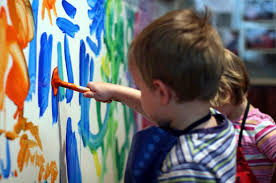In these difficult economic times when school budgets need to be reduced by local boards of education, specials like art education are often the first thing to be cut out of school curricula. However, there are compelling reasons why art should remain an important part of a K -12 curricula even if it means sacrificing in other academic and extracurricular areas.
Plato mentions art schools as early as 400 BC. Art education became popular in the United States in the late 19th and early 20th century and continues to be taught in public schools today. Art education was retained as a part of the core curriculum in the No Child Left Behind Act. However, unlike other areas of the curriculum, schools are not required to assess students in the arts, nor are they required to report on their progress. Therefore, many schools are decreasing the amount of time that students spend studying the arts.
Why Is Art Important?
An art education curriculum is important to students at all grade levels. At the elementary school level, art education helps students enhance their language development. Students are encouraged to describe their art and the art of others. This requires them to use descriptive words and to develop critical linguistic skills.
At the high school level a solid foundation in the arts can lead to different work opportunities. A student may decide to become a traditional painter, sculptor or woodworker or follow a more modern career path and become a graphic artist or a web designer.
At all levels, art education teaches students to be creative, to be thoughtful and to take pride in their work and it teaches them how to accept and use constructive criticism. It also reminds makes them more aware and mindful of their surroundings.
How to Fund Art Education?
As with most academic subjects, the majority of the funding for art education comes from the local school budget. However, school boards, superintendents and concerned parents should be aware that there are other sources of funding available such as an art education grant.
It may be useful to consult your state board of education to see if there are any state grants available to help offset the cost of the art teacher or art supplies for your district.
Additional art education grants are available through private organizations such as the National Endowment for the Arts (NEA). The NEA promotes art education for all students, not just those with exceptional talent. The organization believes that art is very important to the education of all children from prekindergarten through high school.
Art Education Curriculum
There are many different art education curricula available. Each art education curriculum takes a different approach to achieve much the same goals. There is no one curriculum that is right for art education throughout the United States just as there is no one algebra curriculum that works in every high school.
Local art teachers and administrators will need to work together to study different art curricula and art education resources to determine which is the right fit for their school district.
That said, one of the most popular art education curricular models in the United States is called Discipline Based Art Education. Students learn about aesthetics, criticism, art history and studio practices. This approach can be used across all grade levels.
Opportunities for Serious Artists
While art education is undoubtedly important for all students, talented and serious artists often need more art education than their school can provide. Accordingly, many communities have established charter schools or other special high schools that focus on the arts. The budding artists are able to spend more time intensely studying their craft while still receiving all of the core academic education that their peers in the regular high school receive.
When school boards decide their annual budgets they undoubtedly face difficult challenges because there is a set amount of money and many worthwhile programs which require funding. Yet, it is the responsibility of those school boards to make sure that students receive the best education possible. Art education becomes important in that regard as it helps create confident, insightful and sensitive children who become excellent students and productive members of the adult society.



